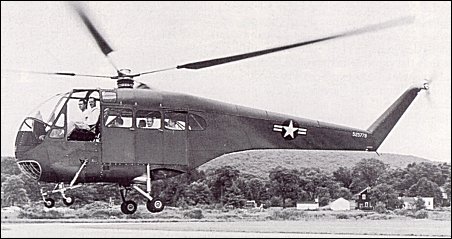
| Doman LZ-5 / YH-31, D-10B 1950 |  |
 |

| Doman LZ-5 / YH-31, D-10B 1950 |  |
 |
|
The LZ-5 was similar to the LZ-4 but used a 400hp supercharged Lycoming 580-D engine, and had numerous detail changes. The first example was N13458 which flew on 27 April 1953. Doman gained a contract from the U.S. Army to supply two aircraft designated YH-31. These were evaluated following delivery in late 1953 but it was felt that the possible maintenance problems of the complex rotor system would cause problems with field maintenance. Consequently, the two aircraft were retired in 1958 following a period of use as executive transports. Doman also designed a small two-seat helicopter, the D-10, to an Army requirement. This would have been powered by an Allison 250 turbine but was not built. Doman actually completed two more development machines in addition to the pair of YH-31s (N94561 and N812). The third aircraft was modified into a new variant - the D-10B - which had a turbocharged Lycoming HIO-720-A1A engine and minor changes and was the subject of a co-production agreement with Fleet in Canada. N812 became CF-IBG-X. A number of deals and production relationships were subsequently established by Doman in an effort to get the LZ.5 into production. Hiller were licenced to build the military version. Doman also entered into an arrangement with Ambrosini in Italy for them to market the D-10B and for production of 20 airframes to be carried out by Aeronautica Sicula at Palermo in Sicily with final assembly at Doman's factory in Danbury, Connecticut. A plan was also devised for Aeronautica Sicula to fit a D-10B with a Turbomeca Astazou turbine. The agreement with the Italians collapsed and a new company was subsequently established as Caribe Doman in Puerto Rico during 1966. Unfortunately, the LZ-5 was obsolete by this time as more modern turbine-powered helicopters flooded onto the market. A further company, Berlin-Doman was formed and a new project launched as the BD-19 but this was also stillborn and the Doman helicopters finally vanished into obscurity. R.Simpson "Airlife's Helicopter and Rotorcraft", 1998
The measurements and layout of this production model very closely resemble those of the hand-made LZ-4. The 8-cylinder supercharged engine is placed beneath the pilot's compartment; the crankshaft is inclined at an angle of 32� and drive engagement to the rotor is through a fluid coupling. The front cabin is big enough to take two pilots; the main cabin has room for six passengers with luggage, or four stretchers or cargo over an area of 3.7 square metres. This helicopter has been supplied to the U.S. Army, where its official designation is YH-31. In order to speed up output for this outlet, Doman decided in 1953 to grant Hiller a licence to manu-facture the mechanical components of the military version, while Doman himself continues independently to produce the LZ-5 com-mercial version. P.Lambermont "Helicopters and Autogyros of the World", 1958
In the spring of 1953 Doman Helicopters introduced their Model LZ-5 eight-place utility aircraft, the second of the firm's designs to incorporate a novel non-articulated, sealed rigid rotor system. The Army purchased two aircraft (serials 52-5779 and -5780) in late 1953 for service test and evaluation with the designation YH-31. The type's unique rotor system was found to provide only a slight increase in performance over that of other, more conventional systems, and was also judged to be more difficult to maintain under field conditions. There was therefore no further YH-31 procurement, and the two service test machines were ultimately converted into VH-31 VIP transports and used in the Washington, DC area until their 1958 withdrawal from the Army inventory. S.Harding "U.S.Army Aircraft since 1947", 1990
|